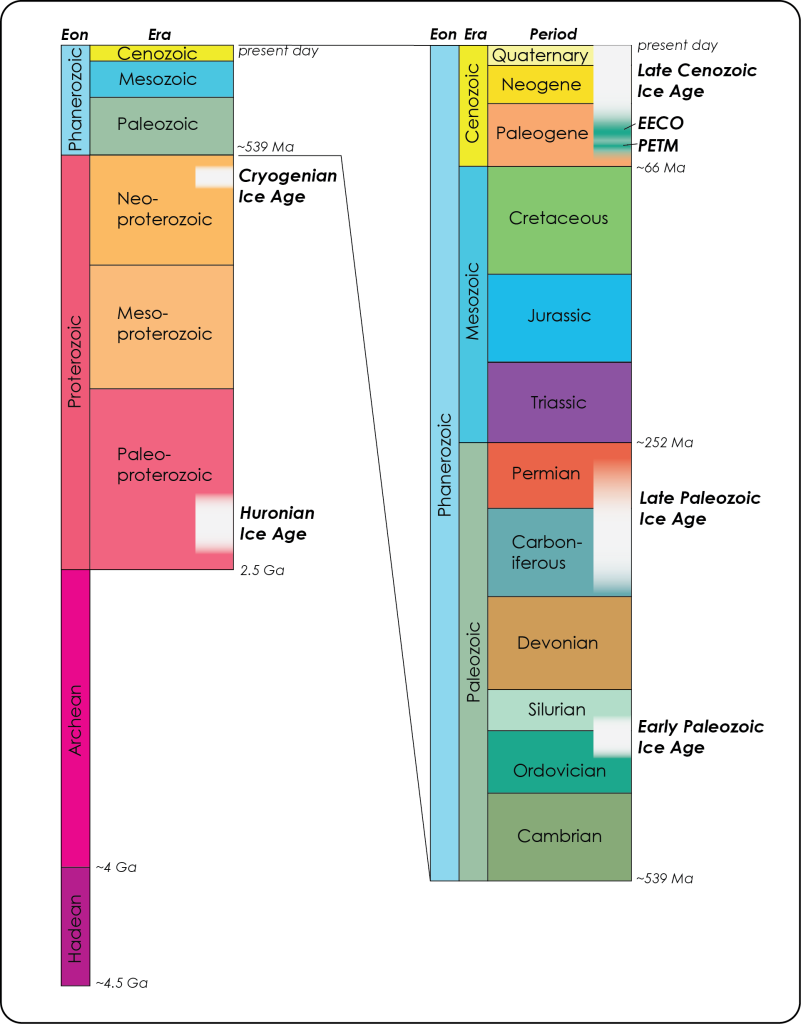1. Overview of Earth’s Climate History
Earth’s climate has fluctuated between cold icehouse conditions and warm greenhouse conditions throughout its history. During an icehouse, or ice age, continental ice sheets are present in one or both polar regions and during a greenhouse the planet is largely ice free. While the majority of Earth’s history has been under greenhouse conditions with temperatures that have exceeded present day temperatures, the greenhouse that existed during the Early Paleogene Period is notable as it is one of the hottest periods in Earth’s history and contains a rapid warming event, the Paleocene-Eocene Thermal Maximum (PETM), which is investigated as the closest analog for the present day warming on the planet, this was followed closely by the Early Eocene Climatic Optimum (EECO), another particularly warm time in an overall greenhouse climate that persisted through the early part of the Paleogene Period (Figure 3B.1.1). The Paleogene Period is the earliest period in the Cenozoic Era, which is the current era.
Earth’s overall warm climate history is punctuated by five major icehouse events (Figure 3B.1.1). The Huronian Ice Age is the oldest icehouse, occurring during the Paleoproterozoic Era (early Proterozoic Eon) between 2.4 and 2.1 billion years ago (Ga). The Cryogenian Ice Age in the Neoproterozoic Era (late Proterozoic Eon) occurred 720 to 630 million years ago (Ma) and is referred to as a “Snowball Earth”, because the planet was so cold that continental ice sheets extended into equatorial latitudes effectively turning the entire planet into a “snowball”. With continuing research on the glacial extent during the Huronian Ice Age, some researchers think it may have been a Snowball Earth event too. The Early Paleozoic Ice Age began around 460 million years ago during the Late Ordovician Period and continued into the Early Silurian Period. The Late Paleozoic Ice Age occurred from about 360 to 260 Ma, during the Carboniferous and Permian Periods. The most recent (and current) ice age is the Late Cenozoic Ice Age, which began with escalated growth of ice sheets on Antarctica about 34 million years ago following the greenhouse conditions of the Early Paleogene Period.

Within an ice age there are times of colder conditions with more extensive ice coverage called glacial periods, or simply glacials, and intervals where climate warms and ice coverage decreases (but is still present) called interglacials. The glacial-interglacial cycles for the current ice age are easily seen in the rock and ice core records, but are harder to resolve for past ice ages, particularly the Proterozoic ice ages, as the geologic record becomes more incomplete and harder to “read” the farther back in time you go. Currently the planet is in an interglacial period within the larger Late Cenozoic Ice Age.
Check your understanding: Ice Age History
References
Hoffman, P. F., Kaufman, A. J., Halverson, G. P., Schrag, D. P. (1998). A Neoproterozoic Snowball Earth. Science, 281(5381), 1342–1346. https://doi.org/10.1126/science.281.5381.1342
Kopp, R. E., Kirschvink, J. L., Hilburn, I. A., Nash, C. Z. (2005). The Paleoproterozoic snowball Earth: A climate disaster triggered by the evolution of oxygenic photosynthesis. Proceedings of the National Academy of Sciences, 102(32), 11131–11136. https://doi.org/10.1073/pnas.0504878102
Kurucz, S., Fralick, P., Homann, M., & Lalonde, S. V. (2021). Earth’s first snowball event: Evidence from the early Paleoproterozoic Huronian Supergroup. Precambrian Research, 365, 106408. https://doi.org/10.1016/j.precamres.2021.106408
